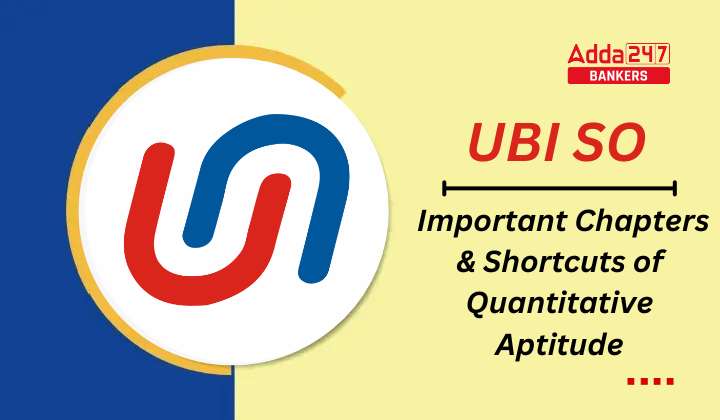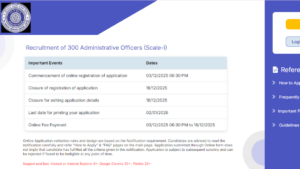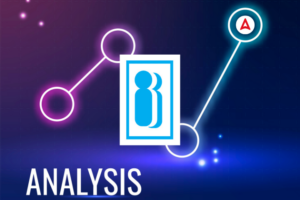The Union Bank of India SO Syllabus 2025 is quite similar to that of other major banking and insurance examinations. Among the various sections, Quantitative Aptitude is a key scoring area that tests your numerical ability, calculation speed, and conceptual clarity. This article focuses on most Important Chapters & Shortcuts for the Union Bank SO.
Important & Scoring Chapters for Union Bank SO Quantitative Aptitude
To succeed in Union Bank SO Recruitment 2025, it’s essential to focus on high-weightage topics and smart solving strategies. This section assesses your numerical ability, calculation speed, and accuracy. To succeed, candidates must focus on the core topics while mastering speed-enhancing shortcuts and tricks. Here’s a refined list of only the most important and scoring chapters, along with shortcuts to help you crack this section.
1. Simplification & Approximation
- Focus on BODMAS, reciprocals, squares, cubes, and decimals.
- Shortcut: Learn Vedic Math techniques for fast calculations and estimation rules to eliminate options.
2. Quadratic Equations
- Involves finding the roots of equations.
- Shortcut: Memorize sign rules for comparing roots of two equations quickly.
3. Percentage
- Foundation for many other chapters like Profit & Loss, SI & CI, etc.
- Shortcut: Use fractions (like 50% = 1/2, 25% = 1/4) to speed up.

4. Ratio & Proportion
- Important for solving partnership, mixture, and time-work problems.
- Shortcut: Practice component and dividend rule and cross-multiplication.
5. Profit & Loss
- Focus on cost price, selling price, discount, and mark-up concepts.
- Shortcut: Learn direct formulas like SP = (100 + profit%)/100 × CP.
6. Time, Speed & Distance
- Includes trains, boats & streams.
- Shortcut: Learn the basic relation: Distance = Speed × Time. Convert units efficiently.
7. Average
- Common in data interpretation as well.
- Shortcut: Use deviation method when the number of elements is large.
8. Simple Interest & Compound Interest
- Shortcut: For CI, use formula for compound growth: CI = P[(1 + R/100)^T – 1].
9. Mensuration
- Includes area and volume of 2D and 3D figures.
- Shortcut: Memorize basic formulas (e.g., volume of cylinder = πr²h, surface area of cube = 6a²).
10. Problems on Trains
- Apply relative speed concept.
- Shortcut: Convert km/hr to m/s using (×5/18) and vice versa (×18/5).
11. Mixtures & Allegation
- Shortcut: Use the allegation rule to find the ratio directly.
12. Probability
- Shortcut: Apply fundamental principle = Favorable Outcomes / Total Outcomes.
13. Permutation & Combination
- Useful in probability-based DI sets.
- Shortcut: Use factorial tricks and understand difference between arrangements and selections.
14. Indices and Surds
- Shortcut: Learn exponent rules and simplification techniques.
15. Partnership
- Based on investment and time.
- Shortcut: Direct ratio of (Capital × Time) gives profit share.
16. Boats & Streams
- Involves upstream and downstream speed.
- Shortcut: Use formulas:
- Downstream Speed = Boat + Stream
- Upstream Speed = Boat – Stream
17. HCF and LCM
- Shortcut: Use division and prime factorization methods for quick calculation.
Tips to Master Quantitative Aptitude for Union Bank SO
Mastering Quantitative Aptitude requires a blend of speed, accuracy, and smart strategy. Here are some tried-and-tested tips to help you perform your best in the Union Bank SO exam:
1. Practice Consistently: Regular practice is the key to building both speed and precision. Make it a habit to solve a mix of topic-wise questions and full-length mock tests in a time-bound manner.
2. Revise Formulas Frequently: Maintain a dedicated formula notebook. Revise it daily to keep all important formulas especially for topics like SI/CI, Time & Work, Mensuration, and Profit & Loss on your fingertips.
3. Use Shortcuts After Mastering Concepts: Shortcuts can save time but only if your basics are strong. First focus on understanding the concepts, then learn and apply tricks for faster solving.
4. Solve Previous Year Papers: Go through previous year question papers to get a clear idea of the exam pattern, question types, and difficulty level. It helps you identify which topics are repeatedly asked.
5. Focus on Accuracy: Accuracy matters more than attempting all questions. Remember, there’s negative marking. Avoid guesswork and aim to maximize correct attempts.
| Related Articles |
| Union Bank SO Syllabus |
| Union Bank SO Salary |




 OICL AO Apply Online 2025 Starts at orie...
OICL AO Apply Online 2025 Starts at orie...
 IBPS PO Interview Call Letter 2025 Out a...
IBPS PO Interview Call Letter 2025 Out a...
 CAIIB BRBL Exam Analysis 2025, 14 Decemb...
CAIIB BRBL Exam Analysis 2025, 14 Decemb...







